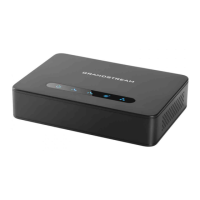P a g e | 42
HT812/HT814 Administration Guide
Version 1.0.9.3
Defines the local RTP-RTCP port pair the HT812/HT814 will listen and
transmit. It is the HT812/HT814 RTP port for channel 0.
The default value for FXS port is 5004
Controls whether to use configured or random SIP ports. This is usually
necessary when multiple HT812/HT814 are behind the same NAT.
Default is No.
Controls whether to use configured or random RTP ports. This is usually
necessary when multiple HT812/HT814 are behind the same NAT.
Default is No.
Allows users to enable RTCP. The default setting is “Yes”.
Allows user to hold or not hold the phone call before referring.
The default setting is Yes.
Refer-To Use Target Contact
Includes target’s “Contact” header information in “Refer-To” header when
using attended transfer. Default is No.
Transfer on Conference
Hang-up
If set to "Yes", when the phone hangs up as the conference initiator, the
conference call
will be transferred to the other parties so that other parties will remain in the
conference call.
Default setting is No.
Disable Bellcore Style 3-Way
Conference
Gives the users the possibility of making conference calls by pressing “Flash”
key, when it’s enabled by dialing *23 +second callee number. Default is No
Remove OBP from Route
Header
Removes outbound proxy info in “Route” header when sending SIP packets.
Default is No.
Includes “SIP Instance ID” attribute to “Contact” header in REGISTER request
as defined in IETF SIP outbound draft. Default is No.
Validate Incoming SIP
Messages
Validates incoming SIP messages. Default is No.
Check SIP User ID for
Incoming INVITE
Checks SIP User ID in the Request URI of incoming INVITE; if it doesn't match
the HT812/HT814 SIP User ID, the call will be rejected. Direct IP calling will
also be disabled. Default is No.
Authenticate Incoming
INVITE
Challenges the incoming INVITE for authentication with SIP 401
Unauthorized message. Default is No.

